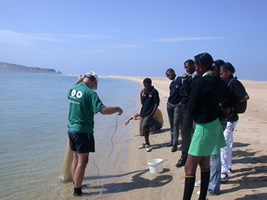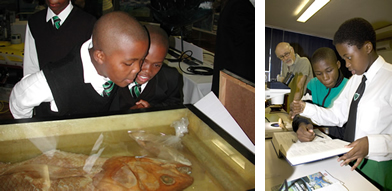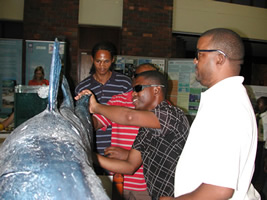| 41% of getS.E.T.go! readers think that the most important benefit of hosting the Square Kilometre Array telescope, would be the boost it gives our international reputation as experts in this field. | |
| 37% opted for “attracting more young people into science and engineering”; and 22% for “foreign investment for local technology projects”. |
Scientists at Stellenbosch University have developed a high-tech "tea bag" filter that fits into the neck of a bottle and turns polluted water into clean water as you drink from it.
Click here to read more.

By Reyhana Mahomed
Biodiversity swam to the fore at this year’s SciFest Africa in Grahamstown, as the South Africa Institute for Aquatic Biodiversity (SAIAB) participated in the daily exhibitions for the first time to date.
Themed “Science in motion”, the week-long SciFest Africa event attracted thousands of visitors, from pupils, students, teachers, lecturers, and scientists right through to the general public.
Around 230 people who attended SAIAB’s talks and workshops are now “in the know” on topics such as using acoustic telemetry to track the movement of fish; taking the mystery out of the scientific naming of fish; and the most popular presentation of all - “Sexy Science! Ships, buoys and robots”, which drew a crowd of some 150 people.
SAIAB’s exhibition fell in line with 2010 being the International Year of Biodiversity, with a display that included banners, posters, a boat and equipment relating to biodiversity research work. The section on the African Coelacanth Ecosystem Programme (ACEP) captured the most attention with its remotely operated vehicle, the coelacanth model and actual coelacanth specimen. Local coelacanth expert, Robin Stobbs, was on hand to answer questions.
Grade 11 and 12 students also got the chance to work alongside SAIAB’s researchers during a series of daily apprenticeship programmes. They then spent a morning exploring SAIAB’s facilities and meeting experts such as Aquatic Biologist, Dr Gavin Gouws and Biomaterials Officer, Unathi Lwana, who showed how samples from collected fish are prepared for future genetic and biochemical research.
They also met Chief Scientist, Professor Alan Whitfield and Aquatic Biologist Dr Nicola James, who took students on a field trip to the Great Fish and Kleinmonde Estuaries, where they uncovered some of the secrets of plants and animals that live in specialised eco systems.
 |
Professor Alan Whitfield explains the art of seine netting to SAIAB’s 2009 Bright Sparks at the Great Fish River. Photo by Nicola James |
 |
Deputy Minister of the DST, Mr Derek Hanekom (left) and his colleagues find out about the coelacanth from Wouter Holleman (right), Research Associate at SAIAB. Photo by Greg Wilmot |

Budding scientists are fascinated by the coelacanth specimen.
Photos by Vanessa Rouhani and Amy Attenborough
 |
A group of blind visitors “see” the coelacanth by explore SAIAB’s life-size model of the fish. Photo Greg Wilmot |
